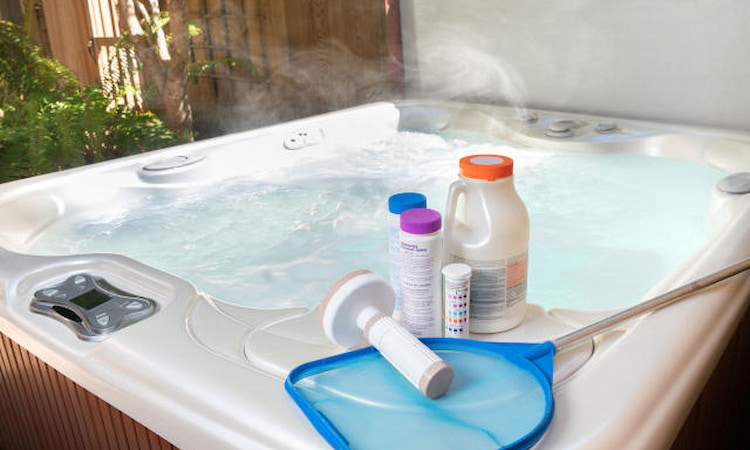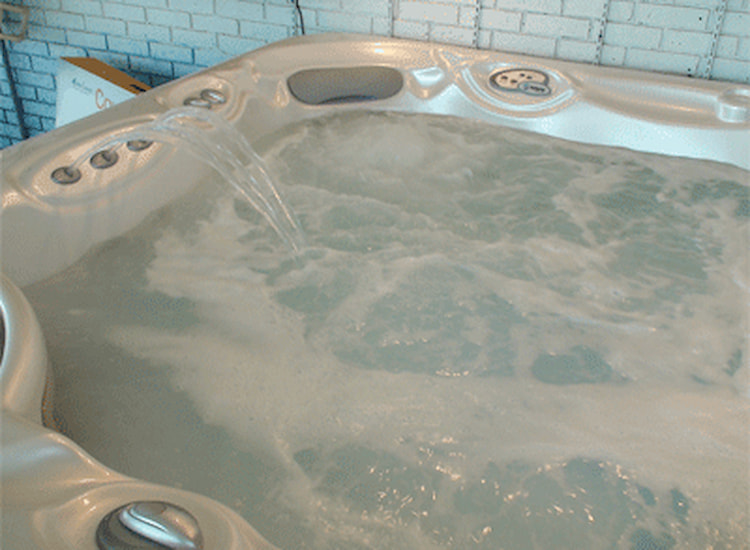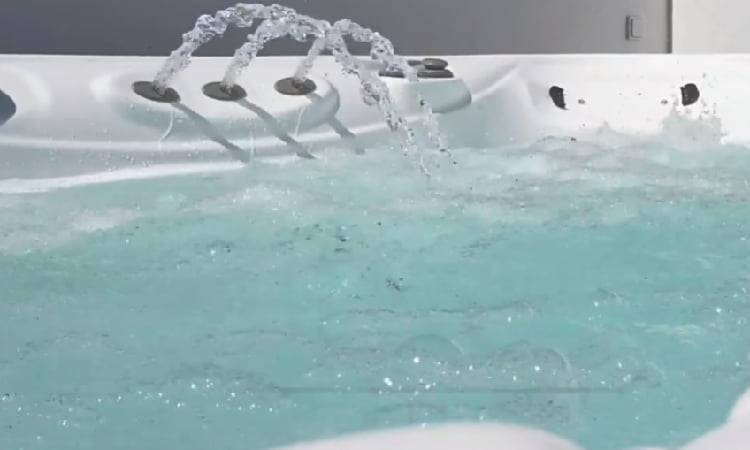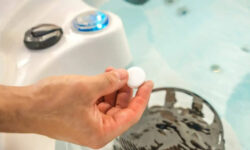You’re ready to enjoy a relaxing soak, but wait! Did you over shock your hot tub? Overdoing it can cause more harm than good. It’s important to understand the process and risks, identify the symptoms, and know the correct steps to take.
Yes, you can over shock a hot tub. Over-shocking a hot tub refers to adding too much sanitizer or chlorine, which can lead to high levels of chemicals in the water. This can be harmful to both the hot tub equipment and its users. Over-shocking can cause skin, eye, and respiratory irritations, and it can also damage the hot tub’s liner and filtering system.
In this article, we’ll guide you through these crucial points and provide measures to rectify an over-shocked hot tub. Let’s ensure you’re maximizing your hot tub’s potential without jeopardizing your health or equipment.

Quick Navigation
Understanding the Process of Shocking a Hot Tub
Before you can determine if it’s possible to over shock your hot tub, you’ve got to understand the five key steps involved in the shocking process.
Firstly, you’ll need to test the water to figure out the existing levels of sanitizer. It’s important to make sure that you’ve got a balanced level of sanitizer before you start. Secondly, you’ll need to pre-dissolve the shock in a separate container. This ensures that you’re not adding too much shock directly to your hot tub.
Thirdly, you’re going to slowly pour the pre-dissolved shock into your hot tub. It’s crucial to pour it slowly, as pouring too quickly could lead to an imbalance in the water. The fourth step is to let the hot tub circulate. You’ve got to give the shock time to work through the water and break down any contaminants.
The Dangers of Over-Shocking Your Hot Tub
While you might think that more is better, over-shocking your hot tub can actually lead to a host of issues that could potentially damage your spa and health. Excessive use of spa shock can cause corrosion to your hot tub’s equipment. You’ll see the impact on heaters, pumps, and seals, shortening their lifespan and leading to costly repairs.
Furthermore, over-shocked water can irritate your skin and eyes. You might notice dryness, itching, or even chemical burns if the situation is severe. This discomfort isn’t limited to your skin, as the vapors from an over-shocked hot tub can cause respiratory problems. Breathing in these fumes can lead to coughing, wheezing, and in some instances, serious lung damage.
Lastly, over-shocking can upset the chemical balance of your hot tub water. This makes it harder to maintain the cleanliness and safety of your spa. It can even cause cloudiness in the water, obstructing your view of the bottom of the tub.
In essence, while shocking is crucial for maintaining your hot tub, exceeding the recommended levels can cause more harm than good. Always adhere strictly to the guidelines to ensure your hot tub remains a safe and enjoyable space.
Identifying Over Shock Symptoms in Your Hot Tub

You might notice certain symptoms in your hot tub, and these can indicate that you’ve over-shocked it. Over-shocking refers to adding an excessive amount of sanitizer to your hot tub, which can cause a range of issues.
The first sign you’ve over-shocked your hot tub is a strong, unpleasant chemical smell. Contrary to popular belief, a well-maintained hot tub shouldn’t smell like chemicals at all. A strong odor can indicate an imbalance and is often a direct result of over-shocking.
Next, if your eyes or skin feel irritated after using the hot tub, it’s possible you’ve added too much shock. High levels of chlorine or other sanitizers can cause these symptoms. If you’re experiencing these, it’s imperative to test your water balance and adjust as necessary.
Additionally, cloudy or foamy water can be a symptom of over-shocking. Healthy hot tub water should be clear and free of foam. If your hot tub water appears murky or has a lot of foam, it’s likely due to an excess of chemicals.
Lastly, if your hot tub components are corroding or if you notice a scale build-up, you’ve probably over-shocked your hot tub. These issues can lead to costly repairs if not addressed promptly.
Steps to Correctly Shock Your Hot Tub
Ironically, it’s not as hard as you’d think to correctly shock your hot tub. The process involves careful measurement and timing to ensure the correct amount of shock is administered. Here are the steps you need to follow.
First, you’ll need to test your hot tub water. This will allow you to ascertain the pH and alkalinity levels, which are vital in determining how much shock to use. You can easily do this using a water testing kit, which is readily available in most home improvement stores.
Next, calculate the amount of shock you’ll need based on the water volume of your hot tub. It’s crucial to follow the manufacturer’s instructions on the shock product. Overdoing it can lead to problems such as cloudy water and potential damage to your hot tub’s internal systems.
Once you’ve determined the correct amount, add the shock to your hot tub water while the jets are running. This will help distribute the shock evenly throughout the tub.
Related Read: How to Shock a Hot Tub For the First Time?
Remedial Measures for an Over-Shocked Hot Tub
If you’ve over-shocked your hot tub, there are several steps you can take, and it’s important to act quickly to prevent any potential damage. The first thing you should do is to stop the hot tub’s filtration system. This will prevent the over-concentration of chemicals from circulating further.
Next, you’ll need to drain some water from the hot tub. This helps to dilute the concentration of sanitizers present. After draining, refill the tub with fresh water. Once completed, let the hot tub circulate the fresh water for at least 15 minutes.
The table below summarizes these steps:
| Steps | Description |
|---|---|
| 1. Stop Filtration | Prevents the circulation of over-concentrated chemicals |
| 2. Drain Water | Reduces the level of sanitizers present |
| 3. Refill with Fresh Water | Dilutes any remaining sanitizers |
| 4. Circulate Water | Ensures the fresh water mixes with any remaining chemicals |
Frequently Asked Questions
Regularly shocking your hot tub maintains water clarity, eliminates bacteria, and gets rid of unpleasant odors. It also prolongs your tub’s lifespan and ensures a safe, enjoyable soaking experience for you.
Yes, you can. Shocking your hot tub too often or using too much shock can damage the tub’s components, bleach your swimsuits, irritate your skin and eyes, and throw off the water’s pH balance.
Yes, the type of hot tub you own does affect how you should shock it. The materials used, their size, and the filtration system all influence the amount and frequency of shock treatment needed.
Absolutely, over-shocking your hot tub can cause skin irritations and other health issues. High levels of chlorine or bromine can dry out skin, cause rashes, and irritate the eyes and the respiratory system. Keep it balanced!
Absolutely, there are alternative methods that are less risky. You could use non-chlorine shock, an oxidizer that’s gentle on the skin. It’s essential to maintain the balance of your hot tub’s water to ensure safety.
Conclusion
In conclusion, while shocking your hot tub is crucial for cleanliness and safety, overdoing it can harm both the tub and its users. Always follow proper shocking procedures, and be on the lookout for signs of over-shocking.
If you’ve over-shocked your hot tub, don’t panic—there are remedial measures available. Keep your hot tub experience safe and enjoyable by using chemicals responsibly.




![What is a Stabilizer in a Hot Tub? [Types of Stabilizers] what is a stabilizer in hot tubs and how does it work](https://hottubtales.com/wp-content/uploads/2023/10/what-is-a-stabilizer-in-hot-tubs-and-how-does-it-work-250x150.jpg)

